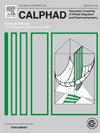Thermodynamic reassessment of the Fe–Pt system
IF 1.9
3区 材料科学
Q4 CHEMISTRY, PHYSICAL
Calphad-computer Coupling of Phase Diagrams and Thermochemistry
Pub Date : 2025-08-30
DOI:10.1016/j.calphad.2025.102868
引用次数: 0
Abstract
In this study, the Fe–Pt binary system was critically reassessed by means of the CALPHAD technique for the applications of the next-generation data storage media. The liquid and A2 phases were modeled as substitutional solutions. The fcc-based phases (L12–Fe3Pt, L10–FePt, L12–FePt3, and A1) were modeled using the split-compound energy formalism (split-CEF) with four sublattices, where the effect of short-range ordering was taken into account through the reciprocal parameters. The formation enthalpies of the fcc-based phases were reproduced well by introducing the regular terms that represent the second-nearest-neighbor interactions in the fcc lattice. The magnetic excess Gibbs energies described by the Inden model were assessed for the fcc-based ordered and disordered phases. The obtained parameter set in the present work can reproduce satisfactorily the key theoretical and experimental data in this system.
Fe-Pt体系的热力学再评价
在这项研究中,通过CALPHAD技术对Fe-Pt二元系统进行了批判性的重新评估,以应用于下一代数据存储介质。液相和A2相被模拟为替代溶液。基于fcc的相(L12-Fe3Pt、L10-FePt、L12-FePt3和A1)采用四个子晶格的分裂-复合能量形式(split-CEF)建模,其中通过互反参数考虑了短程有序的影响。通过引入表示fcc晶格中第二近邻相互作用的规则项,可以很好地再现fcc基相的形成焓。用Inden模型描述了基于fcc的有序相和无序相的磁过剩吉布斯能。本文所得到的参数集能较好地再现系统中的关键理论和实验数据。
本文章由计算机程序翻译,如有差异,请以英文原文为准。
求助全文
约1分钟内获得全文
求助全文
来源期刊
CiteScore
4.00
自引率
16.70%
发文量
94
审稿时长
2.5 months
期刊介绍:
The design of industrial processes requires reliable thermodynamic data. CALPHAD (Computer Coupling of Phase Diagrams and Thermochemistry) aims to promote computational thermodynamics through development of models to represent thermodynamic properties for various phases which permit prediction of properties of multicomponent systems from those of binary and ternary subsystems, critical assessment of data and their incorporation into self-consistent databases, development of software to optimize and derive thermodynamic parameters and the development and use of databanks for calculations to improve understanding of various industrial and technological processes. This work is disseminated through the CALPHAD journal and its annual conference.

 求助内容:
求助内容: 应助结果提醒方式:
应助结果提醒方式:


